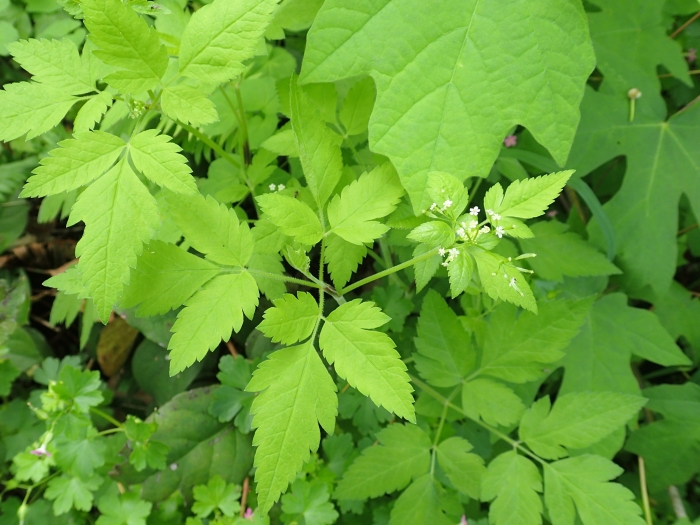Mountain Sweet Cicely
(Osmorhiza berteroi)
Mountain Sweet Cicely (Osmorhiza berteroi)
/
/

Lindsey K. Wise
CC BY 4.0
Image By:
Lindsey K. Wise
Recorded By:
Copyright:
CC BY 4.0
Copyright Notice:
Photo by: Lindsey K. Wise | License Type: CC BY 4.0 | License URL: http://creativecommons.org/licenses/by/4.0/ | Rights Holder: Lindsey K. Wise | Publisher: iNaturalist | Date Created: 2021-05-02T11:26:53-07:00 |

















Estimated Native Range
Summary
Osmorhiza berteroi, commonly known as Mountain Sweet Cicely, is a perennial herb native to the understory of deciduous forests, particularly those with rich, moist soils in temperate regions of North and South America. It often forms a species complex with O. depauperata and O. purpurea. Mountain Sweet Cicely typically grows to a height of 2-3 feet (0.6-0.9 meters) and is characterized by its trifoliate green leaves and small, white flowers arranged in compound umbels, which are most showy from June to early July. The plant produces slender, elongated seeds that have a mechanism for attaching to animal fur, aiding in seed dispersal.
This plant is valued for its aromatic qualities and delicate appearance, making it a charming addition to woodland gardens and shaded borders. It is relatively low-maintenance, requiring minimal care once established in a suitable location. Mountain Sweet Cicely prefers partial to full shade, consistently moist soil, and cool growing conditions. It is not commonly afflicted by serious diseases or pests, but it may suffer from root rot if planted in poorly drained soils. Historically, it has been used in Native American cuisine for its sweet, anise-like flavor and in traditional medicine. However, it is not widely cultivated for these purposes today. Gardeners should be aware that while it is not typically invasive, in some conditions it can self-seed prolifically.CC BY-SA 4.0
This plant is valued for its aromatic qualities and delicate appearance, making it a charming addition to woodland gardens and shaded borders. It is relatively low-maintenance, requiring minimal care once established in a suitable location. Mountain Sweet Cicely prefers partial to full shade, consistently moist soil, and cool growing conditions. It is not commonly afflicted by serious diseases or pests, but it may suffer from root rot if planted in poorly drained soils. Historically, it has been used in Native American cuisine for its sweet, anise-like flavor and in traditional medicine. However, it is not widely cultivated for these purposes today. Gardeners should be aware that while it is not typically invasive, in some conditions it can self-seed prolifically.CC BY-SA 4.0
Plant Description
- Plant Type: Herb
- Height: 1.5-3 feet
- Width: 1-1.5 feet
- Growth Rate: Moderate
- Flower Color: White
- Flowering Season: Spring, Summer
- Leaf Retention: Deciduous
Growth Requirements
- Sun: Part Shade
- Water: Medium
- Drainage: Medium
Common Uses
Bee Garden, Butterfly Garden, Low Maintenance
Natural Habitat
Understory of deciduous forests with rich, moist soils
Other Names
Common Names: Mountain Sweet Cicely, Bertero’s Sweetroot, Mountain Sweetroot, Sweet Cicely, Western Sweet Cicely, Western Sweetroot, Chilean Sweet Cicely
Scientific Names: , Osmorhiza berteroi, Chaerophyllum chilense, Myrrhis berteroi, Myrrhis nuda, Osmorhiza berteroi var. gracilior, Osmorhiza brevipes, Osmorhiza brevistylis, Osmorhiza chilensis, Osmorhiza chilensis var. chilensis
GBIF Accepted Name: